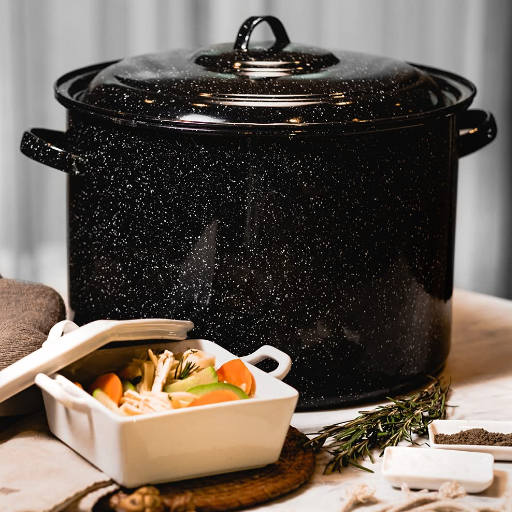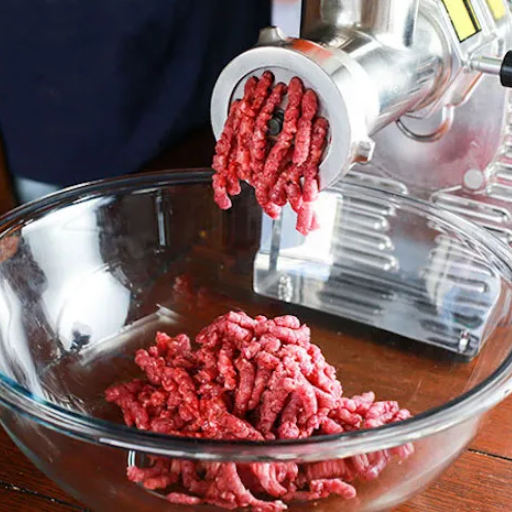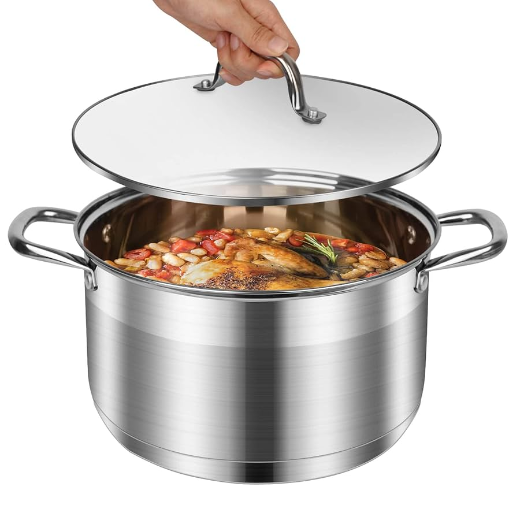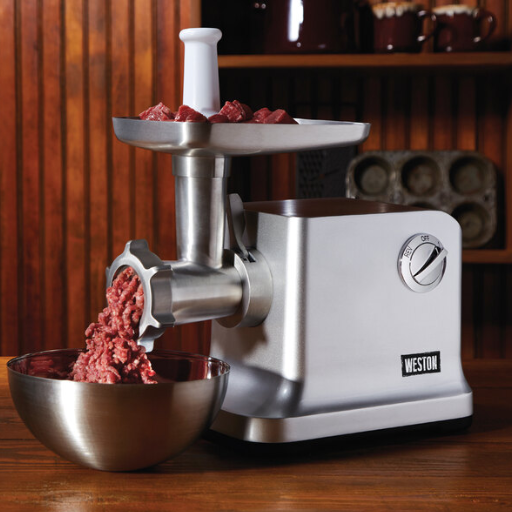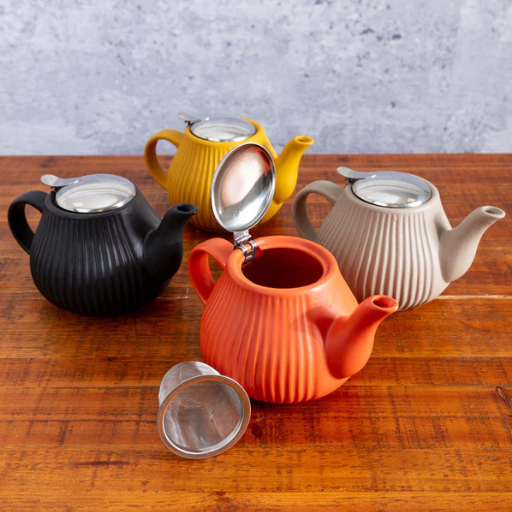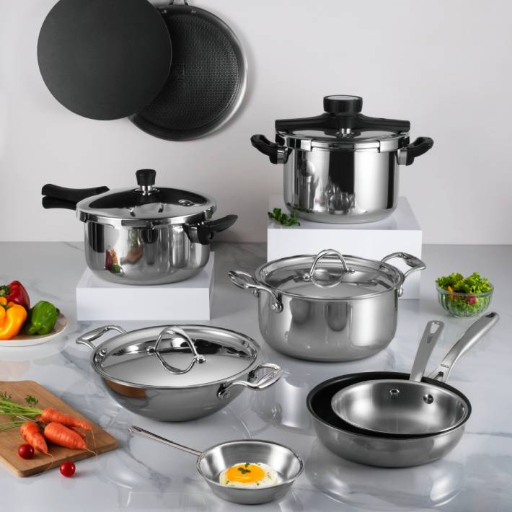Strategic planning and skillful execution are essential for running a successful culinary enterprise. Accurate and consistent high-standard results can be achieved through use of quality cookware. This article focuses on wholesale premium cookware and its effect in optimizing operations, increasing efficiency, and maintaining competitive pricing while sustaining market leadership. For this purpose, we will discuss the advantages of bulk purchasing, the most critical ones pertaining to selection of quality kitchen tools, and the impact reliable suppliers have in attaining success in a business. After reading this piece, you will know the role of good cookware investment towards business elevation, growth, and demand fulfillment in a competitive market.
What are the Benefits of Buying Cookware Wholesale?

- Cost Efficiency
The wholesale purchase method has a lower total cost of acquiring cookware when considered individually due to the bulk price discount. This method increases control over costs and improves profit margin, thus optimizing purchase value.
- Streamlined Inventory Management
The inventory flow is maintained which lessens chances of running out of basic kitchen utensils during peak operational periods. Ordering them less frequently reduces the number of purchase orders, thus streamlining procurement.
- High Customization Potential
Wholesale suppliers frequently offer options for custom labeling and custom orders, allowing businesses to tailor their cookware to fit their brand identity and operational requirements.
- Improved Supplier Relationships
Developing strategic relationships with wholesale suppliers enhances trustworthiness and availability of superior goods at attractive prices, thus providing businesses with a clear competitive edge in the market.
Understanding Wholesale Cookware Pricing
The pricing of wholesale cookware is influenced by the type of materials, the processes of production, and the size of the order. Costly materials, like stainless steel and non-stick coatings, raise prices but add value in terms of dish durability and performance. Economies of scale comes into play here; larger order volumes tend to have a lower price per unit due to reduced costs in production and shipping. Customization options like branding or special features add to the overall cost. Suppliers buy into both ends of the market, enabling businesses to chose based on operational goals and expectations.
How to Choose the Right Cookware Sets for Your Needs
As far as choosing cuisines is concerned, major parts to consider includes the material and type of stove used. Steel is known as a sturdy material and equally offers balanced heating while nonstick is easy to clean and lets food parts slide off freely. Assess the stovetop type for compatibility—certain materials like cast iron do not work well with induction. Durability is also an important part; choose parts that perform well under high temperatures, heavy use, and remain functional. Think about the set size based on their specific requirements and habit to ensure meeting cooking needs. It is critical universally to strike a balance between quality and cost to offer them guaranteed satisfaction.
Key Considerations for Kitchen Utensils
A utensil material is very important to consider when selecting kitchen utensils. For example, grade A stainless steel, silicone and wood are incredibly resistant to wear and heat, and are safe for food use. These materials would be optimal for durable kitchen appliances. Alongside material, ergonomics and usability greatly impact comfort during use, especially during long periods of time. Utensils should be towel shaped so they do not slip out of hand and their structure should be well-balanced. Silicone and wood utensils are well-suited for non-stick cookware, while stainless steel utensils pair excellently with cast iron and stainless steel pans. Lastly, best customer picks tend to be those that include a variety of pieces for multiple cooking functions, assuring wisdom that withstands.
How to Select the Best Stainless Steel Cookware for Your Restaurant?

If purchasing stainless steel cookware for your restaurant, consider first the 18/10 stainless steel grade because it is rust resistant and durable. Check that the cookware has an aluminum or copper core for better heat retention and distribution. As welded handles have no gaps to facilitate food debris build up, choose those for improved hygiene. Depending on your preferred aesthetic, choose pieces with either a brush or mirror finish about ease of cleaning. Moreover, confirm if the cookware is induction, gas or electric compatible and it is safe for dishwashers and ovens. Finally, check customer reviews alongside warranty stipulations for value and long term performance.
Comparing Stainless Steel Cookware Sets
1. Material Compilation: Most high-end cookware sets include an 18/10 alloyed stainless steel due to durability, appearance and corrosion resistance. To further enhance the quality of the cookware, some sets use multi-layered copper or aluminum cores. This incorporated into the cookware enhances heat conduction and distribution for improved performance while cooking.
2.Core and Construction: Choose fully clad or tri ply sets. These terms mean that all the conductive metals necessary are integrated all throughout the cookware and not at the bottom. This allows for even heating throughout eliminating overheating in certain areas or hot spots unlike disk-bottom designs.
3. Number and Type of Pieces: Assess the included pots, pans, and lids included in the set and how they align with your cooking requirements. For broad use, sets that come with a stockpot, skillet, sauté pan, and saucepans of various sizes are particularly useful.
4. Compatibility with Heat Sources: Ensure that the set matches the heat source of your kitchen. A lot of stovetop: gas and electric; and induction compatible stainless steel cookware sets exist, but the induction type requires a magnetic base, which should be confirmed.
5. Ease of Maintenance: Select cookware with a smooth, polished finish to reduce food particles sticking to the surface and make cleaning simpler. Dishwasher-safe cookware is always easily maintained, although hand washing is better. Some sets are oven-safe, which is helpful for recipes that need going from the stovetop to the oven.
With these considerations in mind, you should have no problem choosing the best stainless steel cookware set that fits your needs, style of cooking, kitchen setup and budget.
Evaluating Durability and Quality
Stainless steel cookware durability and quality can be evaluated from the grade of material used, as well as its composition. The best alternatives come with upgraded stainless steel as 18/10, which is an alloy containing 18% chromium and 10% nickel, thus boosting its anti-corrosive properties and shine. Warping over time is minimized with multi-ply construction, especially with tri-ply or five-ply, as heat distribution is enhanced. Important for endurance and the overall condition of the piece are riveted handles and reinforced bases. Furthermore, looking at warranty conditions can shed light on the trust that the maker has placed on the durability of their product. Look for Reverse reviews for repeat concerns that include warped shapes, discoloration, or loose handles in order to make a well-informed selection.
Benefits of Non-stick Coating
Apart from a home cook, a chef also benefits from non-stick coatings because it increases work efficiency and makes cleaning a lot easier. Not only does nondrive increase a healthier lifestyle, but it also helps in the reduction of oil usage in the food. Reduction or no oil usage allows for the easier preparation of a meal. Another benefit is even distribution of heat which is important for burning or unevenly cooked food. Modern non-stick surfaces can withstand scratches and are more durable than previous versions which used to make them brittle and fragile. Many contemporary surfaces use advanced technologies such as ceramic or diamond infused coatings making them last much longer. Another advantage is the amount of cleaning that is required because non-stick surfaces only need to be wiped down with little effort unlike traditional utensils that require scrubbing which makes the time used for maintenance cheaper. For contemporary standards, selecting PFOA free non stick surfaces allows for the use of nonstick surfaces without jeopardizing safety.
What Makes a Premium Cookware Collection?

A premium cookware collection is defined by its materials, performance, and durability. A premium collection incorporates non-stick options with high-quality stainless steel, cast iron, or hard-anodized aluminum. Engineering Advanced ergonomic handles and multi-layered construction improve comfort and usability. Moreover, increasing the premium attributes of the cookware collection is non-toxic used high-performance coatings. Durability is hugely important as the cookware must withstand high temperatures and resist wear over time. The collection must also be versatile, adaptable to various levels of induction heat and range of cooking techniques.
Exploring Tri-ply and Heavy Gauge Aluminum Options
Tri-ply cookware offers an aluminum or copper core sandwiched between two layers of stainless steel to support exterior longevity and stainless protection from corrosion. This guarantees high level tri-ply options to support experts in precision cooking, with features to include: sautéing, simmering, and searing without the worry of ever-changing temperatures. With these pieces often being compatible with induction cooktops, the versatility and ease of switching out heat sources goes hand-in-hand with the use of the durable and swift heat-conducting exterior and copper core for fast, even cooking and improved performance. Enhanced versatility comes with broadened use for different heat sources that ensure equal benefit as induction cooktops.
Each of these Heavy gauge aluminum cookware has a distinct characteristic. They are known to have superb heating conductivity and thus heat quickly. Moreover, they cook evenly. The phrase ‘heavy gauge’ implies that the aluminum is of greater thickness which makes the cookware stronger while also decreasing the chances of warping due to heat. While aluminum is a sturdy strand, it is light at the same time which makes it a useful material for any kind of kitchen. Apart from that, it is essential to note that the fact that aluminum is able to conduct heat with uniformity means that it is highly unlikely that there will be hot spots in the food being cooked. Numerous other options of heavy gauge aluminum also come with nonstick coatings which makes the utilization of these products easier. Regardless of the ease that comes with the use of aluminum cookware, it is necessary to consider that due to the fact that uncoated aluminum can directly react with acidic substances, it is better that anodized or coated alternatives be used.
Importance of Versatile Pots and Pans
Every kitchen requires a versatile set of pots and pans because they can be used for almost every type of cooking. Great quality multi-purpose cookware makes it easier to prepare different recipes through the simplification of tools required, which actually helps with organization in the kitchen. They also withstand frying, sautéing, braising, and stewing. Furthermore, these and other tools are made from different materials such as stainless steel, cast iron, and anodized aluminum. These metals are excellent conductors of heat, amplify its durability, and endure several forms of cooking. Non-stick and oven-safe features lended to these tools further improve their value.
How to Find a Reliable Wholesale Cookware Distributor?

- Reputation and Reviews
Check the reputation of the distributor using their customer reviews, testimonials, and industry evaluation. Trustworthy distributors should be known for offering quality products and having good service consistently.
- Product Range and Quality
Explore the catalog of each supplier and assess the range and standard of the cookware they provide. Also, analyze if their stock meets your expectation in regard to material, durability, and standards of manufacture.
- Pricing and Minimum Order Requirements
Check their pricing system and ascertain whether there are extra costs like shipping. Confirm the minimum order quantities and see if there’s enough space for the stock you wish to buy. Also, make sure the price coincides with your budget.
- Certifications and Compliance
Assure the distributor has not breached industry regulations and check if the necessary certifications for food-grade materials and processes of fabrication have been obtained.
With proper consideration of these aspects, it is possible to find a wholesale distributor of cookware that will serve your business purposes with maximum efficiency.
Understanding Supply Chains and Distribution
In answering the queries for selecting a distributor for cookware, summarized answers based on insights from top sources in the rankings of supply chains are presented here.
- Inventory Alignment
All distributors are expected to provide catalogs or product lists which contain every item needed in the range. Special attention must be given to the core factors like what material it is made of (non-stick, stainless steel, skillet etc.), how long can it last (burability ratings), manufacturings standards set, if it is within the specifications required.
- Pricing Transparency
Demand for a detailed outline of pricing includes: unit price, bulk discount prices, and shipping charges. There should be a cross check on the set order quantities that exist. This is very crucial in ensuring the targets set will achieve cost effectiveness.
- Regulatory Compliance
Verify the distributor has listed as required, FDA compliance, ISO sections for cookware for food grade. These are very essential for legislation and client expectations regarding taste and quality.
Through this approach for evaluation, all the steps are defined for effective supplier selection, greater supplier evaluation efficiency, achieve cost effectiveness against operational goals, and achieve business goals.
Ensuring Free Shipping Options
To maximize the integration of free shipping options, confirm if the retailer has free shipping ranges and bulk purchase promotional benefits. As noted by many competitors, free shipping is often provided by most distributors at preset monetary or weight ranges. Also, check the associated geographical boundaries of the free shipping offer, especially for international domains, in order to avoid additional expenses. Finally, as these policies greatly influence your shipping strategies, request comprehensive policies regarding the terms and conditions that the distributor has concerning shipping.
Why Choose Non-stick Frying Pans for Commercial Use?

Compared to other types of frying pans, non-stick frying pans provide remarkable advantages for use in commercial kitchens because of their ease of use and sturdy construction. As the name enunciates, non-stick frying pans are stick resistant which allow for fast cooking and minimizes food wastage. Stick resistant coating makes it easier to clean the pan, something that is very vital in fast paced environments where time and cleanliness are important. Also, less amount of oil and butter is required which encourages healthy means of cooking and driving down costs. The fact that they maintain an even distribution of heat enables a wider range of dishes from light omelets to seared meats to be cooked, increasing their value for use in numerous cuisines.
Benefits of Nonstick Cookware in Restaurant Settings
In restaurant kitchens, nonstick cookware greatly enhances workflow efficiency and improves food quality. Key benefits include:
1. Reduced Food Waste: Losses when preparing and serving the food are greatly reduced due to easy food release which is enabled because of the nonstick coating.
2. Effort Saving: The nonstick surfaces do not need to be scrubbed or wiped down frequently so that time can be saved hasty restaurant environments.
3. Reduced Fat Usage: Nonstick cookware does not require much cooking oil or butter, allowing chefs to make healthier dishes that still taste good. This characteristic also lowers the cost of ingredients over time.
4.Heat Distribution: High quality nonstick pans are made with even heating features to deliver consistent results with the entire menu, ensuring delicate sauces are just as delicate and hearty proteins are robust.
5. Nonstick Cookware Maintenance: Today’s nonstick cookware are built to endure regular use in commercial settings, providing reliable equipment as well as a smooth cooking surface while supporting high-volume operations.
In any restaurant kitchen, switching to nonstick cookware has the potential to increase efficiency while cultivating gratification from customers.
Maintaining easy-to-clean surfaces
To preserve the nonstick surfaces and ease their cleaning, obedience of care instructions is a must. This includes not using overly harsh cleaners or scrubbers but rather soft sponges with warm water and detergent. The pan has to cool completely before cleaning to maintain the integrity of the coating. Other factors besides cleaners that aid in the preservation of the coating include the type of utensils used. Metal utensils should be avoided and silicone or wooden utensils be used instead. To add, some nonstick pans are more effective if seasoned according to the manufacturer’s instructions. Protective storage also helps minimize nonstick wear. By not stacking unprotected pans, their surfaces can remain resilient. Following these pointers increases the effectiveness and durability of nonstick cookware in high demand commercial kitchens.
Exploring Cast Iron vs. Aluminum Options
Knowing the pros and cons of cast iron and aluminum cookware requires looking into the particular demands of the kitchen, as each of them can serve divers purposes. An example would be a slow cooker, deep oven, or cast iron skillet, as they would keep their food well heated for long durations while also giving room for high temperature searing flavoring. However, cast iron’s weight and need for constant seasoning to protect from rust means greater effort for the user.
For the aluminum counterpart, the ease of use stands out as it is lightweight, heats up evenly and is anodized for added stamina and low weldability with other materials. While all these factors would make the aluminum cookware easy to handle, it still isn’t as tough as cast iron as scratches and dents can become more of an issue, but with far less maintenance being required over time. The two options provide a contrasting amount of strength and heritability, along with how frequently each will need caring for.
References
Frequently Asked Questions (FAQ)
Q: Do you provide custom cookware options for culinary businesses?
A: Indeed, we customize cookware according to business specification. We guarantee quality and functionality suitable for your kitchen.
Q: What are the benefits of using wholesale stainless steel cookware?
A: Wholesale stainless steel cookware is known for its durability, resistance to corrosion, and ability to distribute heat evenly, making it ideal for professional chefs and outdoor cooking alike.
Q: Can I find lightweight camping cookware in your wholesale selection?
A: Yes, we offer lightweight camping cookware designed for outdoor enthusiasts, ensuring convenience without compromising on quality or performance.
Q: What types of kitchen tools and accessories do you sell?
A: Our range of kitchen tools and accessories includes cutlery, bakeware, and various cooking accessories to enhance your culinary experience, whether at home or in a restaurant setting.
Q: Are there any premium stainless steel options in your cookware sets?
A: Absolutely! Our wholesale cookware sets feature premium stainless steel options that combine quality with functionality, perfect for both catering and everyday cooking needs.
Q: How do I choose the right stock pot for my culinary needs?
A: When choosing a stock pot, consider the size based on your cooking volume, the material for heat retention, and whether it fits your cooking style. Our team can help you select the best stock pot for your kitchen.
Q: Do you offer any chafing dishes for catering services?
A: Yes, we provide a selection of chafing dishes suitable for catering, ensuring your food is kept warm and presented beautifully during events.
Q: What is the advantage of using commercial cooking pots from your collection?
A: Our commercial cooking pots are designed for heavy-duty use, providing superior heat distribution and durability, essential for any professional culinary environment.

